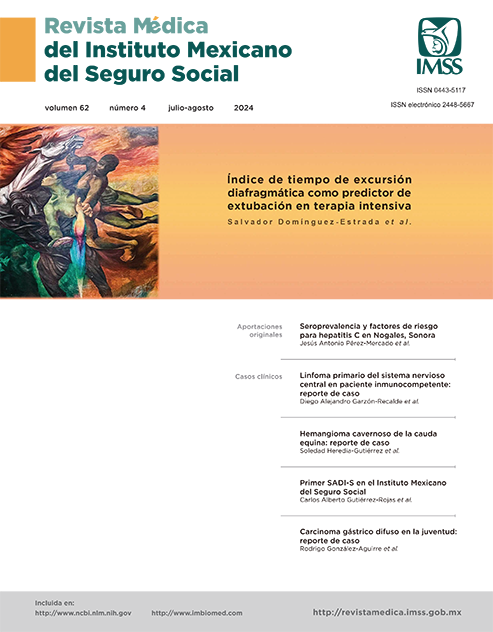Diaphragmatic excursion time index as a predictor of extubation in intensive therapy
Main Article Content
Keywords
Critical Care, Ultrasonics, Diaphragm, Artificial Respiration
Abstract
Background: Extubation is a critical process in the ICU. Pulmonary USG has different applications, those that predict success in extubation, such as the diaphragmatic excursion time index (DEIT).
Objective: To determine the diaphragmatic excursion time index is a predictor of the success of weaning off mechanical ventilation in patients in the intensive care unit.
Material and methods: Diagnostic performance study in patients in the ICU and in the extubation protocol. Diaphragmatic measurement by USG, evaluating DEIT; cut-off point of 2.42 ± 1.55 cm/s. In the hypothesis test, a JI square was carried out between the two qualitative variables, in order to accept or reject H0, with a statistical significance of p < 0.05 to determine if there is dependence between the dependent and independent variables.
Results: Total of 200 patients from the population, with successful extubation in 52.5% and extubation failure in 47.5%. Prognostic values of the DEIT were: S: 77.1% (68.2-84.1%), E: 56.8% (46.8-66.3%). ROC curve for ITED, AUC of 0.665 (0.58-0.74; p = 0.001). In secondary objectives, a correlation was made between ventilatory and demographic variables for successful extubation; with FvT (Rho: 0.680, p = 0.0001).
Conclusions: The DEIT for withdrawal of mechanical ventilation has low sensitivity and specificity as a result of successful extubation. The finding that DEIT is not an adequate predictor determining the outcome of successful extubation.
References
Vivier E, Mekontso-Dessap A, Dimassi S, et al. Diaphragm ultrasonography to estimate the work of breathing during noninvasive ventilation. (Intensive Care Med) 2020 May; 38 (5): 796-803. doi:10.1007/s00134-012-2547-7.
Bach JR, Saporito LR., Criteria for extubation and tracheostomy tube removal for patients with ventilatory failure. A different approach to weaning. (Chest). 2020 Dic; 110 (6): 1566- 71. doi: 10.1378/chest.110.6.1566.
Ferrari G, De Filippi G, Elia F, et al. Diaphragm ultrasound as a new index of discontinuation from mechanical ventilation. (Crit Ultrasound J). 2019 Jun 7; 6 (1): 8. doi: 10.1186/2036-7902-6-8.
Llamas-Álvarez AM, Tenza-Lozano EM, Latour-Pérez J. Diaphragm and Lung Ultrasound to Predict Weaning Outcome: Systematic Review and Meta-Analysis. (Chest). 2019 Dic; 152 (6): 1140-1150. doi: 10.1016/j.chest.2017.08.028.
Ruan SY, Teng NC, Wu HD, et al. Durability of weaning success to release from invasive mechanical ventilation: an analysis of a national database. (Am J Respir Crit Care Med). 2022 Sep 15; 196 (6): 792-795. doi: 10.1164/rccm.201610-2153LE.
MacIntyre N. Discontinuing mechanical ventilatory support. (Chest). 2022 Sep; 132 (3): 1049-56. doi: 10.1378/chest. 06-2862.
Frutos-Vivar F, Esteban A, Apezteguia C, et al. Outcome of reintubated patients after scheduled extubation. (J Crit Care). 2021 Oct; 26 (5): 502-509. doi: 10.1016/j.jcrc.2010.12.015.
Esteban A, Alía I, Tobin MJ, et al. Effect of spontaneous breathing trial duration on outcome of attempts to discontinue mechanical ventilation. Spanish Lung Failure Collaborative Group. (Am J Respir Crit Care Med). 2019 Feb; 159 (2): 512-8. doi: 10.1164/ajrccm.159.2.9803106.
Epstein SK, Ciubotaru RL, Wong JB. Efecto de la extubación fallida en el resultado de la ventilación mecánica. (Pecho). julio de 2022; 112 (1): 186-92. doi: 10.1378/chest.112.1.186.
Plant PK, Owen JL, Elliott MW. Early use of non-invasive ventilation for acute exacerbations of chronic obstructive pulmonary disease on general respiratory wards: a multicentre randomised controlled trial. (Lancet). 2020 Jun 3; 355 (9219): 1931-5. doi: 10.1016/s0140-6736(00)02323-0.
Esteban A, Alía I, Ibañez J, et al. Modes of mechanical ventilation and weaning. A national survey of Spanish hospitals. (The Spanish Lung Failure Collaborative Group. Chest). 2018 Oct; 106 (4): 1188-93. doi: 10.1378/chest.106.4.1188.
Esteban A, Anzueto A, Frutos F et al. Mechanical Ventilation International Study Group. Characteristics and outcomes in adult patients receiving mechanical ventilation: a 28-day international study. (JAMA). 2022 Jun 16; 287 (3): 345-355. doi: 10.1001/jama.287.3.345.
Tobin MJ. Mechanical ventilation. (N Engl J Med). 2022 Apr 14; 330 (15): 1056-1061. doi: 10.1056/NEJM199404143301507.
Cooper LM, Linde-Zwirble WT. Medicare intensive care unit use: analysis of incidence, cost, and payment. (Crit Care Med). 2021 Nov; 32 (11): 2247-2253. doi: 10.1097/01.ccm. 0000146301.47334.bd.
Wagner DP. Economics of prolonged mechanical ventilation. (Am Rev Respir Dis). 2020 Agost; 140 (2 Pt 2): 114-118. doi: 10.1164/ajrccm/140.2_Pt_2.S14.
Epstein SK. Decision to extubate. (Intensive Care Med). 2020 May; 28 (5): 535-46. doi: 10.1007/s00134-002-1268-8.
Coplin WM, Pierson DJ, Cooley KD, et al. Implications of extubation delay in brain-injured patients meeting standard weaning criteria. (Am J Respir Crit Care Med). 2019 May; 161 (5): 1530-1536. doi: 10.1164/ajrccm.161.5.9905102.
Esteban A, Alía I, Tobin MJ, et al. Effect of spontaneous breathing trial duration on outcome of attempts to discontinue mechanical ventilation. (Spanish Lung Failure Collaborative Group. Am J Respir Crit Care Med). 2020 Feb; 159 (2): 512-8. doi: 10.1164/ajrccm.159.2.9803106.
Yang KL, Tobin MJ. A prospective study of indexes predicting the outcome of trials of weaning from mechanical ventilation. (N Engl J Med). 2021 May 23; 324 (21): 1445-1450. doi: 10.1056/ NEJM199105233242101.
Matić I, Majerić-Kogler V. Comparison of pressure support and T-tube weaning from mechanical ventilation: randomized prospective study. (Croat Med J). 2021 Abr; 45 (2): 162-6.
Jones DP, Byrne P, Morgan C, et al. Positive end-expiratory pressure vs T-piece. Extubation after mechanical ventilation. (Chest). 2021 Dic; 100 (6): 1655-9. doi: 10.1378/chest.100.6. 1655.
Perren A, Domenighetti G, Mauri S, et al. Protocol-directed weaning from mechanical ventilation: clinical outcome in patients randomized for a 30-min or 120-min trial with pressure support ventilation. (Intensive Care Med). 2022 Agost; 28 (8): 1058-63. doi: 10.1007/s00134-002-1353-z.
Namen AM, Ely EW, Tatter SB, et al. Predictors of successful extubation in neurosurgical patients. (Am J Respir Crit Care Med). 2021 Mar; 163 (3 Pt 1): 658-664. doi: 10.1164/ajrccm. 163.3.2003060.
Koh WY, Lew TW, Chin NM, et al. Tracheostomy in a neuro-intensive care setting: indications and timing. (Anaesth Intensive Care). 2022 Aug; 25 (4): 365-8. doi: 10.1177/ 0310057X9702500407.


